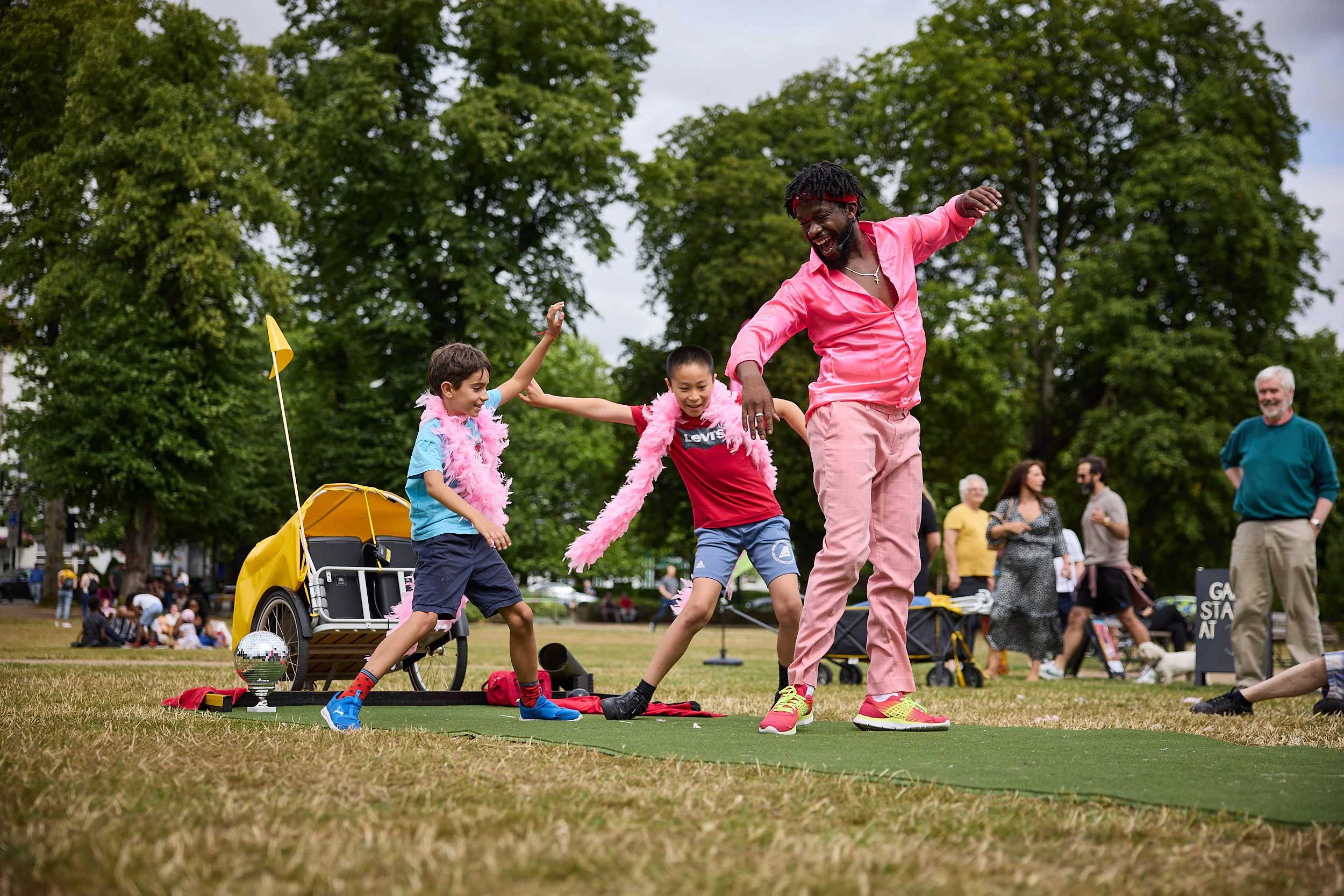Appendix: Co-design and engagement programme results
The online consultation survey was live and reached 509 of people.
Headlines from the survey: 96% of respondents believe major cuts to culture and the arts in Birmingham makes the city a less attractive place to live, work and invest. Respondents see investing in culture and arts as essential for economic growth, social cohesion, and maintaining Birmingham’s identity as a diverse and creative hub.
Respondents were specifically concerned the impact the cuts would have on:
The economy: Cuts to arts and culture risk reducing tourism and the night time economy, diminishing revenue for local businesses, including restaurants, bars, hotels, and shops.
Loss of identity and vibrancy: Birmingham's cultural heritage, from music to diverse art forms, defines its identity. Without it, the city risks becoming bland and unattractive.
Community cohesion and wellbeing: Cultural activities foster social inclusion, community building, and mental wellbeing, providing essential platforms for connection and expression.
Credit: Will Pace
Credit: Joe Bailey
Credit: Ex Cathedra at Hereford Cathedral
The survey asked respondents to describe how the future cultural plans should reflect the diversity of Birmingham in a way that makes sure it’s inclusive for all. Here are the top three suggestions:
Community representation in decision-making
Ensure diverse cultural voices, including underrepresented groups (POC, LGBTQ+, disabled individuals, carers, and older adults), are included in planning, leadership, and funding decisions.
Support for grassroots initiatives
Invest in smaller, local arts organisations, community-led projects, and underserved neighbourhoods rather than focusing solely on large city centre institutions.
Access and affordability
Remove financial and logistical barriers by offering free or low-cost events, improving transport links, and bringing cultural activities into local communities.
Respondents mentioned the need for inclusive cultural programming to celebrate all cultural heritages, embracing and listening to the perspectives of the younger generation, and ensuring venues and materials were physically and linguistically accessible to accommodate different needs. The desire to recognise Birmingham’s historical roots was also highlighted, from its industrial and post colonialism past to its waterways and celebrating the unique stories and contributions from all communities.
Credit: Simon Hadley
The survey then asked how the plan should ensure the younger generation of Birmingham have opportunities within arts and culture in the future.
The majority of responses focused in on the role of academia, and access to the arts from a young age:
Prioritise arts education in schools
Integrate music, art, drama, and creative writing into the curriculum to inspire students from an early age and ensure sustained exposure to the arts.
Provide accessible and affordable programmes
Develop free or low-cost arts and culture programmes and make sure they are accessible to young people from all socioeconomic backgrounds.
Support community arts and youth centres
Invest in youth centres, community spaces, and libraries as hubs for arts activities, workshops, and engagement outside of schools.
The need for investment in talent development and career pathways was mentioned frequently, such as providing paid internships, apprenticeships, and mentorship programmes for young creatives. Funding talent development initiatives with cultural institutions was also seen as important for creating clear pathways into creative industries.
When asked to describe what Birmingham is renowned for that maybe isn’t as widely recognised, respondents came up with lots of examples to showcase Birmingham’s vibrant cultural and artistic achievements. These deserve greater recognition and celebration on national and international platforms:
Music heritage
Birthplace of heavy metal (Black Sabbath, Judas Priest), home to reggae giants like Steel Pulse, and renowned bands like Duran Duran and UB40.
The city’s diverse music scene, including bhangra, jazz, folk, grime, and urban genres – currently lacks visible celebration.
Literary connections
J.R.R. Tolkien’s inspiration for The Lord of the Rings came from Birmingham landscapes like Moseley Bog and Sarehole Mill.
Influential writers like Benjamin Zephaniah and Jonathan Coe also hail from the city.
Theatre and dance excellence
Home to Birmingham Royal Ballet, Birmingham Rep, and Birmingham Hippodrome – yet it’s felt these these world-class venues lack nationwide recognition.
Smaller theatres (The Old Rep Theatre, Crescent Theatre) and amateur productions offer rich cultural output but remain under-promoted.
Specifically, developments including spaces for culture could help:
Foster community and belonging
Cultural spaces create social hubs, connect diverse communities, and combat isolation by providing inclusive, accessible areas for creativity, interaction, and engagement.
Support artists and creative industries
Affordable rehearsal studios, exhibition spaces, and collaborative hubs allow artists, musicians, and freelancers to work, showcase their talent, and sustain their careers locally.
Improve mental health and wellbeing
Access to cultural activities and creative expression fosters relaxation, reduces stress, and improves mental wellbeing for residents.
Respondents also suggested that this should not be reserved for new developments but should be extended to repurposing existing buildings – for example heritage sites, unused properties and shop fronts could be opened up and used by local groups as cultural hubs.
Credit: Johan Persson
Many respondents highlighted the rich cultural diversity of what Birmingham offers – from festivals like Birmingham Mela, Caribbean Festival, and B-SIDE Hip-Hop Festival to the famous Balti Triangle and Bhangra music. It was also felt that the historic craftsmanship of the Jewellery Quarter and displays of public art, murals, and street art – particularly in Digbeth and the Custard Factory area – were often overlooked and not valued as much as they should be, both culturally and economically.
The survey asked if new developments in the city should include spaces for culture and why. People were overwhelmingly positive to this idea. By including spaces for culture in developments, it was seen that Birmingham could continue to grow economically, socially, and creatively, ensuring the city remains a vibrant, livable place for all.
Face-to-face and online workshops – summary
Alongside the online survey, we held a number of workshops with young people and organisations representing diverse communities.
Young adults, aged between 18–30, attended a workshop organised in partnership with Birmingham City University.
From our discussion with these young adults it became clear that Birmingham’s young creatives face significant challenges in accessing affordable cultural spaces. Many independent venues are closing and high costs make it difficult for emerging artists to sustain their work. While areas like Digbeth remain cultural hotspots, gentrification threatens their grassroots identity, pushing out underground scenes like street art and independent music. By contrast, the city centre feels overly corporate and lacks cultural vibrancy. There is a disconnect between students studying in Birmingham and the cultural scene, as many live outside the city centre and struggle to find opportunities after graduation. Limited career prospects and financial instability further discourage young people, particularly from working-class backgrounds, from pursuing arts and culture careers, leading to talent drain to London.
The group discussed solutions to address these issues, such as creating affordable, rotating cultural hubs in unused spaces, protecting existing venues, and expanding cultural programming into underrepresented areas like Small Heath. Talent retention and increased accessibility could be improved by strengthening connections between creative institutions, businesses, and artists through mentorship programmes and visible city-wide showcases. There is also a need for better wayfinding and guidance to help people navigate Birmingham’s fragmented cultural scene. The group thought that embracing street art and grassroots movements as part of the city's identity – rather than pushing them out – could help Birmingham maintain its unique creative spirit, while ensuring culture is both sustainable and inclusive for all communities.
Credit: David Furmage
Young people, aged 13–16, attended a workshop organised in partnership with Birmingham Ormiston Academy.
Young people in Birmingham face significant barriers to accessing and engaging with the city's cultural scene due to a lack of awareness, affordability issues, and limited career pathways in the arts. Many talked about feeling disconnected from cultural opportunities unless they are part of an existing network. They also felt that the city's rich diversity is not widely reflected or celebrated on a national scale. Training and education in the arts are also lacking, with limited GCSE options, few established arts colleges outside London, and a general perception that creative careers are financially unstable. Representation was also a key concern – many felt excluded from cultural spaces due to high ticket prices and a lack of diversity in performances and audiences.
To address these challenges, the group discussed increasing visibility through social media campaigns, youth ambassadors, and more cultural festivals to highlight Birmingham’s diverse arts scene. This group also said that expanding arts education in schools, creating more apprenticeships, and establishing a cultural careers service would help young people see a viable future in creative industries. And a stronger cultural identity could be fostered by encouraging investment in local productions, showcasing homegrown talent, and integrating arts education into youth centres. Ultimately, reframing the arts as a valued and respected career path while ensuring accessibility and inclusivity would help Birmingham build a more vibrant and engaging cultural landscape for its young people.
Group leaders representing community organisations and underrepresented groups attended a workshop hosted at The Legacy Centre.
This group of community group leaders in Birmingham felt that, while the city has a strong cultural foundation, there is a need for more inclusive leadership, improved funding structures, and stronger support for creatives at all career levels. They emphasised the importance of placing artists and creatives in senior decision-making roles and creating a more connected cultural leadership network. They also called for greater collaboration between grassroots organisations and larger institutions, flexible funding that supports creative work without restrictive criteria, and more resilience training for freelancers beyond initial development programmes. This group also highlighted the need to rebrand Birmingham from its industrial past to a thriving creative city, making culture a core part of the city's identity.
In terms of inclusivity and representation, leaders feel the cultural sector must better reflect Birmingham’s diverse communities, with more opportunities for younger generations and grassroots creatives. They felt the city centre does not adequately represent Birmingham’s multiculturalism, and more efforts to break down class and social barriers are needed. This group came up with suggestions for this too, including a dedicated multicultural Birmingham festival, a revitalised ArtFest, and curated cultural displays at major transport hubs to celebrate local identities. Increasing networking opportunities, supporting small organisations with financial security, and establishing a cultural sector working group could also ensure long-term inclusivity and sustainability. By fostering better communication, accessible funding, and a more welcoming approach to community involvement, Birmingham’s cultural sector can become more representative and empowering for all.
Credit: David Furmage
Group leaders with a specific focus on young people attended an online workshop.
The youth group leaders emphasised the need for greater inclusion and representation in Birmingham’s cultural strategy, particularly through the creation of a youth version of the Cultural Compact to ensure young voices shape decision-making. The group commented that many communities, including those classified as ‘White Other’ and faith-based groups, feel excluded from cultural opportunities, and there is a lack of investment in underrepresented areas like East Birmingham. They suggested a gap analysis to assess where funding has been allocated and identify self-funded grassroots groups that provide cultural activities but lack formal support. They also had a discussion around inconsistent arts funding, which makes it difficult for youth engagement programmes to sustain long-term impact beyond short-term initiatives like holiday activity programmes.
It was felt that strengthening Birmingham’s cultural ecosystem requires greater collaboration between small arts organisations, developers, and Arts Council NPOs to support sustainable growth and workforce development. Expanding cultural access beyond the city could also help them to build professional networks and new career paths for young people. Leaders highlighted the need for intergenerational cultural literacy, encouraging families to support young people in creative careers while fostering entrepreneurial opportunities in the arts. Grassroots initiatives like Free@Last, Essence Mentoring, and Kings Heath United’s Spoken Word project show just how powerful community-driven cultural development can be. Strengthening regional networks, improving access to funding, and embedding youth perspectives in cultural leadership will be key to ensuring a more inclusive and thriving creative sector in Birmingham.
Credit: David Furmage












